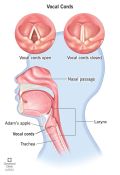Sound is air vibrations. Voice production depends on airflow, pitch, resonance and articulation.
Airflow: the diaphragm muscle pushes up on the lungs, pressuring air up through trachea
You can strengthen it and improve breathing for a more powerful/loud voice.
-
Voice producing systems
-
Vocal Cords
Pitch: The vocal cords chop up the flow of air from the trachea by opening and closing at a frequency which depends on their size and how tense the muscle is. The frequency of vibration will determine if will be a high or low pitch.
Resonance: Sound is amplified and modified by the vocal tract resonators like the throat, mouth cavity, and nasal passages. The resonators increase the loudness of certain frequencies and attenuate (decrease loudness) of other frequencies.
Articulation: The vocal tract articulators like the tongue, soft palate, and lips modify the voiced sound. The articulators produce recognizable words. You can think of this as an accent or way of speaking.

